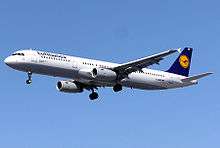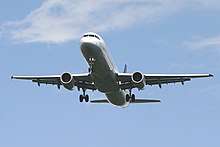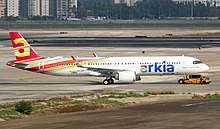Airbus A321
The Airbus A321 is a member of the Airbus A320 family of short to medium range, narrow-body, commercial passenger twin engine jet airliners[lower-alpha 2] and carries 185 to 236 passengers. It has a stretched fuselage which was the first derivative of the baseline A320 and entered service in 1994 about six years after the original A320. The aircraft shares a common type rating with all other Airbus A320-family variants, allowing previous A320-family pilots to fly the aircraft without the need for further training.
| A321 | |
|---|---|
_%E2%80%98N915US%E2%80%99_American_Airlines_(28442733186).jpg) | |
| An A321-200 of American Airlines, the largest operator. | |
| Role | Narrow-body jet airliner |
| National origin | Multinational[lower-alpha 1] |
| Manufacturer | Airbus |
| First flight | 11 March 1993 |
| Introduction | 1994 with Lufthansa |
| Status | In service |
| Primary users | American Airlines China Southern Airlines Delta Air Lines China Eastern Airlines |
| Produced | 1992–present |
| Number built | 2,116 as of 31 July 2020[1] |
| Unit cost |
US$114.9 million[2] |
| Developed from | Airbus A320 |
| Developed into | Airbus A321neo |
In December 2010, Airbus announced a new generation of the A320 family, the A320neo (new engine option).[3] The similarly lengthened fuselage A321neo variant offers new, more efficient, engines, combined with airframe improvements and the addition of winglets (called Sharklets by Airbus). The aircraft delivers fuel savings of up to 15%. The A321neo carries up to 244 passengers, with a maximum range of 4,000 nmi (7,400 km; 4,600 mi) for the long-range version when carrying no more than 206 passengers.[4]
Final assembly of the aircraft takes place in Hamburg, Germany, or Mobile, Alabama. As of 31 December 2019, a total of 2,043 A321 aircraft have been delivered, of which 2,015 are in service. In addition, another 3,003 airliners are on firm order (comprising 38 A321ceo and 2,965 A321neo). As of December 2019, American Airlines was the largest operator of the Airbus A321, operating 231 aircraft.[1]
Development

The Airbus A321 was the first derivative of the A320, also known as the Stretched A320, A320-500 and A325.[5][6] Its launch came on 24 November 1988, around the same time as the A320 entered service, after commitments for 183 aircraft from 10 customers were secured.[5][7]
.jpg)
The maiden flight of the Airbus A321 came on 11 March 1993, when the prototype, registration F-WWIA, flew with IAE V2500 engines; the second prototype, equipped with CFM56-5B turbofans, flew in May 1993. Lufthansa and Alitalia were the first to order the stretched Airbuses, with 20 and 40 aircraft requested, respectively. The first of Lufthansa's V2500-A5-powered A321s arrived on 27 January 1994, while Alitalia received its first CFM56-5B-powered aircraft on 22 March 1994.[8] The A321-100 entered service in January 1994 with Lufthansa.
Final assembly for the A321 was carried out in Germany (then West Germany), a first for any Airbus.[9] This came after a dispute between the French, who claimed that the move would incur $150 million (€135 million) in unnecessary expenditure associated with the new plant,[5] and the Germans, who claimed that it would be more productive for Airbus in the long run. The second production line was located in Hamburg, which later produced the smaller Airbus A319 and A318. For the first time, Airbus entered the bond market, through which it raised $480 million (€475 million) to finance development costs.[7] An additional $180 million (€175 million) was borrowed from European Investment Bank and private investors.[10]
The A321 is the largest variant of the A320 family.[11][4] The A321-200's length exceeds 44.5m, increasing maximum takeoff weight to 93,000 kg (205,000 lb).[5] Wingspan remained unchanged, supplementing various wingtip devices. Two suppliers provided turbofan engines for the A321: CFM International with its CFM56 and International Aero Engines with the V2500 engine, both in the thrust range of 133–147 kN (30,000–33,000 lbf).
Over 30 years since launch, the A321 Maximum takeoff weight (MTOW) grew by 20% from the 83t -100 until the 101t A321XLR, seating is 10% more dense with 244 seats, up by 24, and range doubled from 2,300 nmi to 4,700 nmi.[12] By 2019, 4,200 have been ordered—one-quarter of all Airbus single-aisles—including 2,400 neos, one-third of all A320neo orders.[12]
Design

The Airbus A321 is a narrow-body (single-aisle) aircraft with a retractable tricycle landing gear and is powered by two wing pylon-mounted turbofan engines. It is a low-wing cantilever monoplane with a conventional tail unit having a single vertical stabilizer and rudder. Changes from the A320 include a fuselage stretch and some modifications to the wing. The fuselage was lengthened by a 4.27 m (14 ft 0 in) plug ahead of the wing and a 2.67 m (8 ft 9 in) plug behind it, so that the A321 is 6.94 metres (22 ft 9 in) longer than the A320.[4][11][5][13] The length increase required the overwing window exits of the A320 to be converted into door exits and repositioned in front of and behind the wings.[8] To maintain performance, double-slotted flaps and minor trailing edge modifications were included,[5] increasing the wing area from 124 m2 (1,330 sq ft) to 128 m2 (1,380 sq ft).[14] The centre fuselage and undercarriage were reinforced to accommodate the increase in maximum takeoff weight of 9,600 kg (21,200 lb), taking it to 83,000 kg (183,000 lb).[5]
Variants

A321-100
The original derivative of the A321, the A321-100, had a shorter range compared to the A320 as extra fuel tankage was not added to the initial design to compensate for the extra weight. The MTOW of the A321-100 is 83,000 kg (183,000 lb). The A321-100 entered service with Lufthansa in 1994. Only about 90 were produced.[15]
A321-200
Airbus launched the heavier and longer-range A321-200 development in 1995 which has a full-passenger transcontinental US range. This is achieved through higher thrust engines (V2533-A5 or CFM56-5B3), minor structural strengthening, and an increase in fuel capacity with the installation of one or two optional 2,990 L (790 US gal) tanks in the rear underfloor hold.[13] The additional fuel tankage increases the total capacity of this model to 30,030 L (7,930 US gal). These modifications also increased the maximum takeoff weight of the A321-200 to 93,000 kg (205,000 lb). This variant first flew in December 1996, and entered service with Monarch Airlines in April 1997. Its direct competitors include the 757-200 and the 737-900/900ER.
A321neo
.jpg)
On 1 December 2010, Airbus launched the A320neo family (neo for New Engine Option) with 500 nmi (930 km) more range and 15% better fuel efficiency thanks to new CFM International LEAP-1A or Pratt & Whitney PW1000G engines and large sharklets.[16] The lengthened A321neo prototype made its first flight on 9 February 2016.[17] It received its type certification on 15 December 2016.[18] The first entered service in May 2017 with Virgin America.[19]
A321LR

In October 2014, Airbus started marketing a longer range 97 t (214,000 lb) maximum takeoff weight variant with three auxiliary fuel tanks with 100 nmi (190 km) more operational range than a Boeing 757-200.[20] Airbus launched the A321LR (Long Range) on 13 January 2015 with a range of 4,000 nmi (7,400 km) with 206 seats in two classes.[21][22] On 31 January 2018, it completed its first flight.[23] Airbus announced its certification on 2 October 2018.[24] On 13 November 2018, Arkia received the first A321LR.[25]
A321XLR
In January 2018, Airbus was studying an A321LR variant with a further increased MTOW.[26] The proposed A321XLR with a range extended to 4,500 nmi (8,300 km) would be launched in 2019 to enter service in 2021 or 2022 to compete with the Boeing NMA.[27] In November, Airbus indicated that the A321XLR would have an MTOW over 100 t (220,000 lb) and 700 nmi (1,300 km) more range than the A321LR.[28] The A321XLR was launched at the June 2019 Paris Air Show, with 4,700 nmi of range from 2023, including a new permanent Rear Centre Tank (RCT) for more fuel, a strengthened landing gear for a 101 t (223,000 lb) MTOW; and an optimised wing trailing-edge flap configuration to preserve take-off performance.[29]
Operators
As of 29 February 2020, 2,038 Airbus A321 aircraft were in service with more than 100 operators.[1]
American Airlines and China Southern Airlines operate the largest A321 fleets of 234 and 127 aircraft respectively.[1]
Orders and deliveries
| Type | Orders | Deliveries | ||||||||||||||||||||||||||||||
|---|---|---|---|---|---|---|---|---|---|---|---|---|---|---|---|---|---|---|---|---|---|---|---|---|---|---|---|---|---|---|---|---|
| Total | Backlog | Total | 2020 | 2019 | 2018 | 2017 | 2016 | 2015 | 2014 | 2013 | 2012 | 2011 | 2010 | |||||||||||||||||||
| A321 | 1,791 | 34 | 1,757 | 4 | 38 | 99 | 183 | 222 | 184 | 150 | 102 | 83 | 66 | 51 | ||||||||||||||||||
| A321neo | 3,440 | 3,081 | 359 | 69 | 168 | 102 | 20 | — | — | — | — | — | — | — | ||||||||||||||||||
| Total | 5,231 | 3,115 | 2,116 | 73 | 206 | 201 | 203 | 222 | 184 | 150 | 102 | 83 | 66 | 51 | ||||||||||||||||||
| Type | Deliveries | |||||||||||||||||||||||||||
|---|---|---|---|---|---|---|---|---|---|---|---|---|---|---|---|---|---|---|---|---|---|---|---|---|---|---|---|---|
| 2009 | 2008 | 2007 | 2006 | 2005 | 2004 | 2003 | 2002 | 2001 | 2000 | 1999 | 1998 | 1997 | 1996 | 1995 | 1994 | |||||||||||||
| A321 | 87 | 66 | 51 | 30 | 17 | 35 | 33 | 35 | 49 | 28 | 33 | 35 | 22 | 16 | 22 | 16 | ||||||||||||
| A321neo | — | — | — | — | — | — | — | — | — | — | — | — | — | — | — | — | ||||||||||||
| Total | 87 | 66 | 51 | 30 | 17 | 35 | 33 | 35 | 49 | 28 | 33 | 35 | 22 | 16 | 22 | 16 | ||||||||||||
Accidents and incidents
For the Airbus A321, 32 aviation accidents and incidents have occurred,[31] including six hull-loss accidents / criminal occurrences with a total of 377 fatalities as of August 2019.[32][33]
Specifications
.jpg)
| Variant | A321[4] | A321neo[34] |
|---|---|---|
| Cockpit crew | 2 | |
| 2-class seats | 185 (16F @ 36 in, 169Y @ 32 in)[35] | 206 (16J @ 36 in + 190Y @ 30 in)[36] |
| 1-class max. | 220[37][38] | 240 @ 28 in[39] |
| Cargo capacity | 51.70 m3 (1,826 cu ft) / 10×LD3-45s[lower-alpha 3] | |
| Length | 44.51 m (146.0 ft) | |
| Wingspan | 35.80 m (117 ft 5 in) [lower-alpha 4] | |
| Wing | 122.4 m2 (1,318 sq ft) area, 25° sweep[40] | |
| Height | 11.76 m (38.6 ft) | |
| Fuselage | 3.95 by 4.14 m (13.0 by 13.6 ft) width × height, 3.70 m (12.1 ft) wide cabin | |
| Max. takeoff weight | 93.5 t (206,000 lb) | 97 t (213,800 lb) |
| Max. payload | 25.3 t (56,000 lb) | 25.5 t (56,200 lb)[41]:3–2-1 |
| Op. empty weight | 48.5 t (107,000 lb)[35] | 50.1 t (110,500 lb) |
| Fuel capacity | 24,050–30,030 L (6,350–7,930 US gal) | 23,700 - 32,940 l (6,261 - 8,700 US gal)[lower-alpha 5] |
| Engines (×2) | CFM56-5B, 68.3 in (1.73 m) fan IAE V2500A5, 63.5 in (1.61 m) fan |
CFM International LEAP-1A, 78 in (1.98 m) fan Pratt & Whitney PW1100G, 81 in (2.06 m) fan |
| Max. Thrust (×2)[42] | 133–147 kN (30,000–33,000 lbf) | 147.3 kN (33,110 lbf) |
| Speed | Cruise: Mach 0.78 (450 kn; 833 km/h)[43] Max.: Mach 0.82 (473 kn; 876 km/h)[42] | |
| Ceiling | 39,100–39,800 ft (11,900–12,100 m)[42] | |
| Typical range | 3,200 nmi (5,930 km)[lower-alpha 6] | LR: 4,000 nmi (7,410 km)[lower-alpha 7] |
Engines
| Aircraft model | Certification date | Engines[42] |
|---|---|---|
| A321-111 | 27 May 1995 | CFM56-5B1 |
| A321-112 | 15 February 1995 | CFM56-5B2 or 5B2/P |
| A321-131 | 17 December 1993 | IAE Model V2530-A5 |
| A321-211 | 20 March 1997 | CFM56-5B3 or 5B3/P or 5B3/2P |
| A321-212 | 31 August 2001 | CFM56-5B1 or 5B1/P or 5B1/2P |
| A321-213 | 31 August 2001 | CFM56-5B2 or 5B2/P |
| A321-231 | 20 March 1997 | IAE Model V2533-A5 |
| A321-232 | 31 August 2001 | IAE Model V2530-A5 |
See also
Related development
Aircraft of comparable role, configuration and era
Related lists
- List of Airbus A320 operators
- List of jet airliners
Notes
- The Airbus A321 is built in Hamburg, Germany or Mobile, Alabama, United States
- Airbus was originally a consortium of European aerospace companies named, Airbus Industrie, and is now fully owned by Airbus, originally named EADS. Airbus' name has been Airbus SAS since 2001.
- no Additional Centre Tank
- with sharklets
- 0 - 3 Additional Centre Tank[41]
- sharklets, typical Passengers and bags
- with 206 passengers
References
- "Airbus Orders & Deliveries". Airbus. 30 June 2020. Archived from the original on 10 October 2017. Retrieved 8 July 2020.
- "New Airbus aircraft list prices for 2015". Airbus (Press release). 13 January 2015. Archived from the original on 16 November 2016. Retrieved 17 November 2016.
- "Airbus offers new fuel saving engine options for A320 Family". Airbus. 1 December 2010. Retrieved 31 December 2011.
- "A321 specifications". Airbus.
- Norris, Guy; Wagner, Mark (1999). Airbus. St. Paul, Minnesota: MBI Publishing. pp. 50–53. ISBN 0-7603-0677-X.
- Laming, Tim; Hewson, Robert (2000). Airbus A320. Zenith Imprint. p. 23. ISBN 0-7603-0902-7.
- Reed, Arthur (1992). Airbus: Europe's High Flyer. Zürich, Switzerland: Norden Publishing House. p. 84. ISBN 3-907150-10-4.
- Eden, Paul E., ed. (2008). Civil Aircraft Today. London: Amber Books. p. 25. ISBN 978-1-905704-86-6.
- Sebdon, Gilbert (7 February 1990). "A321 victory for West Germany". Flight International. Retrieved 24 February 2011.
- Norris & Wagner 1999, p. 52
- "Specifications Airbus A320". Airbus. Retrieved 13 February 2012.
- Max Kingsley Jones (15 July 2019). "The incredible evolution of Airbus's biggest single-aisle". Flightglobal.
- Gunston, Bill (2009). Airbus: The Complete Story. Sparkford, Yeovil, Somerset, UK: Haynes Publishing. pp. 213–215. ISBN 978-1-84425-585-6.
- Moxon; Julian (17 March 1993). "A321: Taking on the 757". Flight International. Retrieved 25 February 2011.
- "Airbus A321-100 Production List". www.planespotters.net. Retrieved 16 September 2017.
- "Airbus offers new fuel saving engine options for A320 Family" (Press release). Airbus. 1 December 2010.
- "Airbus A321neo completes first flight after engine switch". Reuters. 9 February 2016.
- "Airbus A321neo with P&W engines receives Type Certification" (Press release). Airbus. 15 December 2015.
- Aaron Karp (20 April 2017). "Virgin America receives first A321neo as Alaska mulls future fleet". Air Transport World. Aviation Week.
- "Exclusive: Airbus launches "A321neoLR" long range to replace 757-200W". Leeham News. 21 October 2014.
- "Airbus Launches Long-Range A321neo". Aviation International News. 13 January 2015.
- "Airbus Launches Long-Range A321neo Version". Aviation Week. 13 January 2015.
- "Airbus A321LR long-range jet completes maiden flight". Reuters. 31 January 2018.
- "EASA and FAA certify long-range capability for A321neo" (Press release). Airbus. 2 October 2018.
- David Kaminski Morrow (13 November 2018). "Arkia chief: A321LR first single-aisle to beat 757-300 economics". Flightglobal.
- Jens Flottau (31 January 2018). "Airbus Studying Higher-Capacity A321neo". Aviation Week Network.
- Jens Flottau and Guy Norris (20 July 2018). "Airbus Moves Ahead With A321XLR Definition". Aviation Week & Space Technology.CS1 maint: uses authors parameter (link)
- "Airbus indicates A321XLR would have over 100t MTOW". Flightglobal. 13 November 2018.
- "Airbus launches longest range single-aisle airliner: the A321XLR" (Press release). Airbus. 17 June 2019.
- "Historical Orders and Deliveries 1974–2009". Airbus S.A.S. January 2010. Archived from the original (Microsoft Excel) on 23 December 2010. Retrieved 10 December 2012.
- Airbus A321 occurrences. Aviation Safety, 3 October 2017.
- Airbus A321 hull-loss occurrences. Aviation Safety, 3 October 2017.
- A321 accident statistics. Aviation Safety, 3 October 2017.
- "Airbus Family figures" (PDF). Airbus. July 2017.
- "All About the Airbus A320 Family". Airbus. 2009.
- "Airbus Launches Long-Range A321neo Version". Aviation Week. 13 January 2015.
- "A321ceo specs". Airbus. Retrieved 21 February 2020.
- Kaminski-Morrow, David (24 April 2014). "Airbus indicates potential for 240-seat A321neo". Flight Global. Retrieved 21 February 2020.
- "Airbus reveals new A321neo layout: New 'Cabin-Flex' and larger doors". Australian business traveller. 13 June 2014.
- "Airbus Aircraft Data File". Civil Jet Aircraft Design. Elsevier. July 1999.
- "A321 aircraft characteristics - airport and maintenance planning" (PDF). Airbus. 1 February 2019.
- "Type Certificate Data Sheet" (PDF). EASA. 22 February 2019. Archived from the original (PDF) on 6 March 2019. Retrieved 27 March 2019.
- "Airbus A320neo Technology". Airbus. Archived from the original on 3 April 2016.